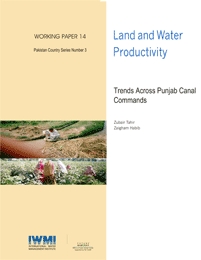Land and water productivity: trends across Punjab canal commands.
Citation:
Tahir, Zubair; Habib, Zaigham. 2000. Land and water productivity: trends across Punjab canal commands. Colombo, Sri Lanka: International Water Management Institute (IWMI) vi, 35p. [IWMI Working Paper 14]
Abstract
As a consequence of green revolution in 1960s, though irrigated areas and agriculture production has increased considerably, yields are still less as compared to various countries of the world. Furthermore, huge spatial variation in cropping pattern and productivity of land and water within irrigated agriculture of Pakistan has become a chronic issue. There are various reasons causing low production. These include farmers’ investment potential, physical environments, market mechanism and availability of water, which is the most precious input in farming. The role of irrigation water resources and its management is extremely important. The sustainability of agriculture can be largely insured through proper and better management of water resources. Indus Basin Irrigation System (IBIS) is basically supply-based by its design which means water is not supplied according to crop requirement. Low gross production is an inherent limitation of this supply-based system. The research activity aims to see the spatial variation in production across canal commands using gross production indicators i.e. Gross Value of Production (GVP) per unit of land and GVP per unit of water. Give of major network of 12, inter-linked and a total of 23 canals out of 45 canals of IBIS. The analysis is performed at the canal command level.
ISBN: 92-9090-435-6


